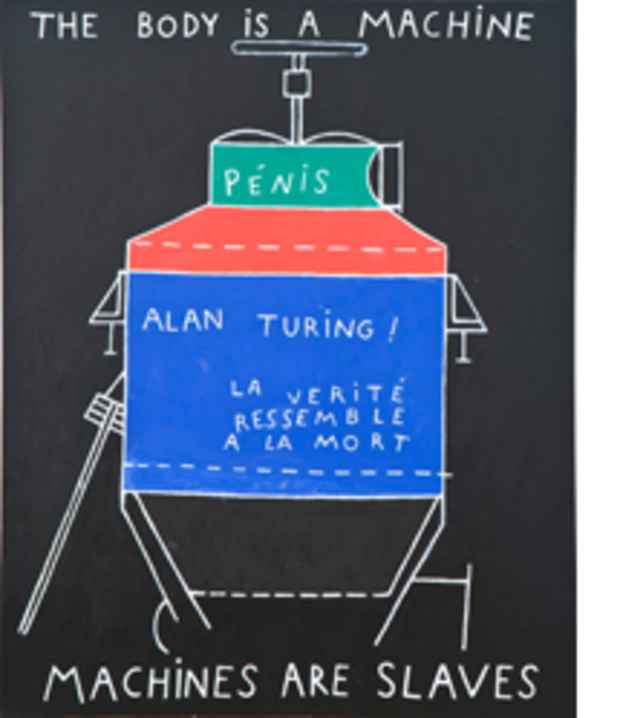“Ghosts in the Machine” Exhibition
The New Museum of Contemporary Art

This event has ended.
“Ghosts in the Machine” surveys the constantly shifting relationship between humans, machines, and art. Occupying the Museum’s three main galleries, the exhibition examines artists’ embrace of and fascination with technology, as well as their prescient awareness of the ways in which technology can transform subjective experience. International in scope, “Ghosts in the Machine” spans more than fifty years and incorporates works by a range of historical figures and contemporary artists from fifteen countries. Together, the works on view will trace the complex journey from the mechanical to the optical to the virtual, looking at the ways in which humans have projected anthropomorphic behaviors onto machines and how those machines have become progressively more human. Eschewing a traditional chronological approach, “Ghosts in the Machine” has been conceived as an encyclopedic cabinet of wonders, bringing together an array of artworks and non-art objects to create an unsystematic archive of man’s attempt to reconcile the organic and the mechanical.
This exhibition is the most recent of the New Museum’s ambitious thematic surveys examing tendencies in international artistic inquiry and production. With such exhibitions as “Ostalgia” (2011), “Free” (2010), “After Nature” (2008), and “Unmonumental” (2007), as well as its Triennial, “The Generational,” the Museum seeks to provide the public with fresh perspectives on the relationships between art and the culture at large.
Henrik Olesen, The Body is a Machine, 2010. Oil on canvas, 40 x 31 in (100 x 80 cm). Collection Museum für Gegenwartskunst, Basel. Courtesy Galerie Buchholz, Berlin/CologneThe installation at the New Museum will include artists, writers, and visionaries whose work has explored the fears and aspirations generated by the technology of their time. From Jacob Mohr’s influencing machines to Emery Blagdon’s healing constructions, “Ghosts in the Machine” brings together improvised technologies charged with magical powers. Historical works by Hans Haacke, Robert Breer, Otto Piene, and Gianni Colombo, among others, will be displayed alongside reconstructions of lost works and realizations of dystopian mechanical devices invented by figures like Franz Kafka. “Ghosts in the Machine” also takes its cue from a number of exhibitions designed by artists that incorporated modern technology to reimagine the role of art in contemporary societies, including Richard Hamilton’s “Man, Machine and Motion” (1955). Exploring the integration of art and science, “Ghosts in the Machine” also tries to identify an art historical lineage of works preoccupied with the way we imagine and experience the future, delineating an archeology of visionary dreams that have never become a reality.
Many of the artists in the show take a scientific approach to investigating the realm of the invisible, dismantling the mechanics of vision in order to conceive new possibilities for seeing. Central to the exhibition is a re-examination of Op Art and perceptual abstraction, with a particular focus on the work of painters Bridget Riley, Victor Vasarely, Richard Anuskiewicz, Julian Stanczak, amongst others. Op Art was unique in the way it internalized technology and captured both the ecstatic and threatening qualities it posed to the human body. Furthermore, the exhibition will include a number of kinetic and “programmed” artworks as well as expanded cinema pieces, which amplify the radical effects of technology on vision. A section of the exhibition will present a selection of experimental films and videos realized with early computer technology. One highlight of the installation will be a reconstruction of Stan VanDerBeek’s Movie-Drome (1963–66), an immersive cinematic environment where the viewer is bathed in a constant stream of moving images, anticipating the fusion of information and the body, typical of the digital era.
The works in “Ghosts in the Machine” are assembled across a variety of media to form a pre-history of the digital age. As technology has accelerated and proliferated dramatically over the past twenty years, artists have continued to monitor its impact. A number of contemporary artists, including Mark Leckey, Henrik Olesen, and Christopher Williams, will be represented in the exhibition. These recent works, while reflecting technological changes, also display a fascination with earlier machines and the types of knowledge and experiences that are lost as we move from one era to the next, constantly dreaming up new futures that will never arrive.
“Ghosts in the Machine” will be accompanied by a fully illustrated catalogue featuring essays by Massimiliano Gioni, Associate Director and Director of Exhibitions, Gary Carrion-Murayari, Curator, and art historian Megan Heuer. The catalogue will also include over three-hundred pages of reprints on historical documents, theoretical texts, interviews, and manifestos providing a rich, intellectual context for the artists
and works in the show.
Media
Schedule
from July 18, 2012 to October 07, 2012
Artist(s)
Bridget Riley, Victor Vasarely, Richard Anuskiewicz, Julian Stanczak et al.